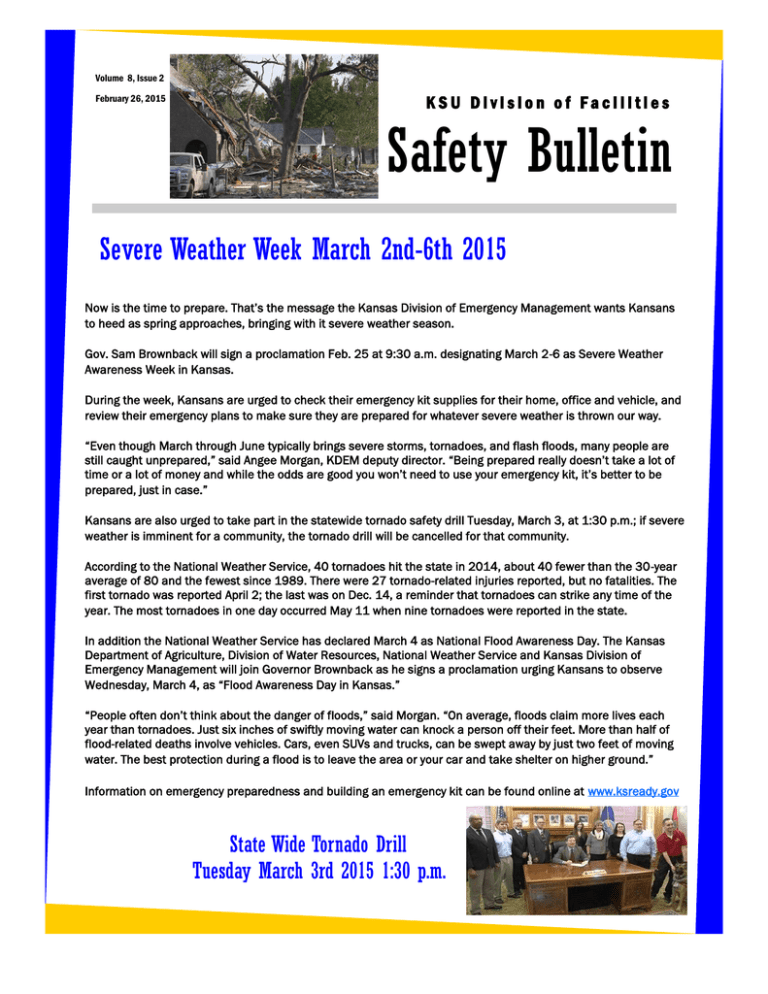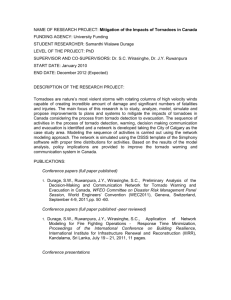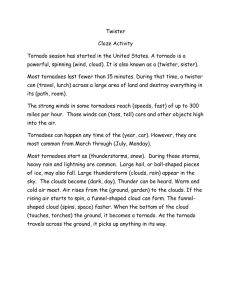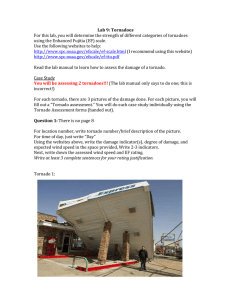Safety Bulletin Severe Weather Week March 2nd-6th 2015
advertisement

Volume 8, Issue 2 February 26, 2015 KSU Division of Facilities Safety Bulletin Severe Weather Week March 2nd-6th 2015 Now is the time to prepare. That’s the message the Kansas Division of Emergency Management wants Kansans to heed as spring approaches, bringing with it severe weather season. Gov. Sam Brownback will sign a proclamation Feb. 25 at 9:30 a.m. designating March 2-6 as Severe Weather Awareness Week in Kansas. During the week, Kansans are urged to check their emergency kit supplies for their home, office and vehicle, and review their emergency plans to make sure they are prepared for whatever severe weather is thrown our way. “Even though March through June typically brings severe storms, tornadoes, and flash floods, many people are still caught unprepared,” said Angee Morgan, KDEM deputy director. “Being prepared really doesn’t take a lot of time or a lot of money and while the odds are good you won’t need to use your emergency kit, it’s better to be prepared, just in case.” Kansans are also urged to take part in the statewide tornado safety drill Tuesday, March 3, at 1:30 p.m.; if severe weather is imminent for a community, the tornado drill will be cancelled for that community. According to the National Weather Service, 40 tornadoes hit the state in 2014, about 40 fewer than the 30-year average of 80 and the fewest since 1989. There were 27 tornado-related injuries reported, but no fatalities. The first tornado was reported April 2; the last was on Dec. 14, a reminder that tornadoes can strike any time of the year. The most tornadoes in one day occurred May 11 when nine tornadoes were reported in the state. In addition the National Weather Service has declared March 4 as National Flood Awareness Day. The Kansas Department of Agriculture, Division of Water Resources, National Weather Service and Kansas Division of Emergency Management will join Governor Brownback as he signs a proclamation urging Kansans to observe Wednesday, March 4, as “Flood Awareness Day in Kansas.” “People often don’t think about the danger of floods,” said Morgan. “On average, floods claim more lives each year than tornadoes. Just six inches of swiftly moving water can knock a person off their feet. More than half of flood-related deaths involve vehicles. Cars, even SUVs and trucks, can be swept away by just two feet of moving water. The best protection during a flood is to leave the area or your car and take shelter on higher ground.” Information on emergency preparedness and building an emergency kit can be found online at www.ksready.gov State Wide Tornado Drill Tuesday March 3rd 2015 1:30 p.m. TORNADO Emergency officials recommend people use the following safety tips: Know the terms: WATCH means a tornado is possible. WARNING means a tornado has been spotted; take shelter immediately. Know where the nearest safe room is, such as a basement or interior room and away from windows, and go there immediately if you hear or see a tornado. If driving, you should leave your vehicle immediately to seek safety in an adequate structure. Do not try to outrun a tornado in your vehicle, and do not stop under an overpass or a bridge. If you are outdoors, and there is no shelter available, take cover in a low-lying flat area. Watch out for flying debris. Following a storm, wear sturdy shoes, long sleeves and gloves when walking on or near debris, and be aware of exposed nails and broken glass. Be aware of damaged power or gas lines and electrical systems that may cause fires, electrocution or explosions. FLOODS Water weighs 62.4 lbs. per cubic foot and typically flows downstream at 6 to 12 mph. When a vehicle stalls in the water, the water’s momentum is transferred to the car. For each foot the water rises, 500 lbs. of lateral force is applied to the automobile. But the biggest factor is buoyancy. For each foot the water rises up the side of the car, the car displaces 1500 lbs. of water. In effect, the automobile weighs 1500 lbs. less for each foot the water rises. Two feet of water will carry away most automobiles!!! LIGHTNING NO PLACE outside is safe when thunderstorms are in the area!! Stay in safe shelter at least 30 minutes after you hear the last sound of thunder. Stay off corded phones, computers and other electrical equipment that put you in direct contact with electricity. Avoid plumbing, including sinks, baths and faucets. If you hear thunder, lightning is close enough to strike you. When you hear thunder, immediately move to safe shelter: a substantial building with electricity or plumbing or an enclosed, metal-topped vehicle with windows up. Stay away from windows and doors, and stay off porches. Do not lie on concrete floors, and do not lean against concrete walls.




